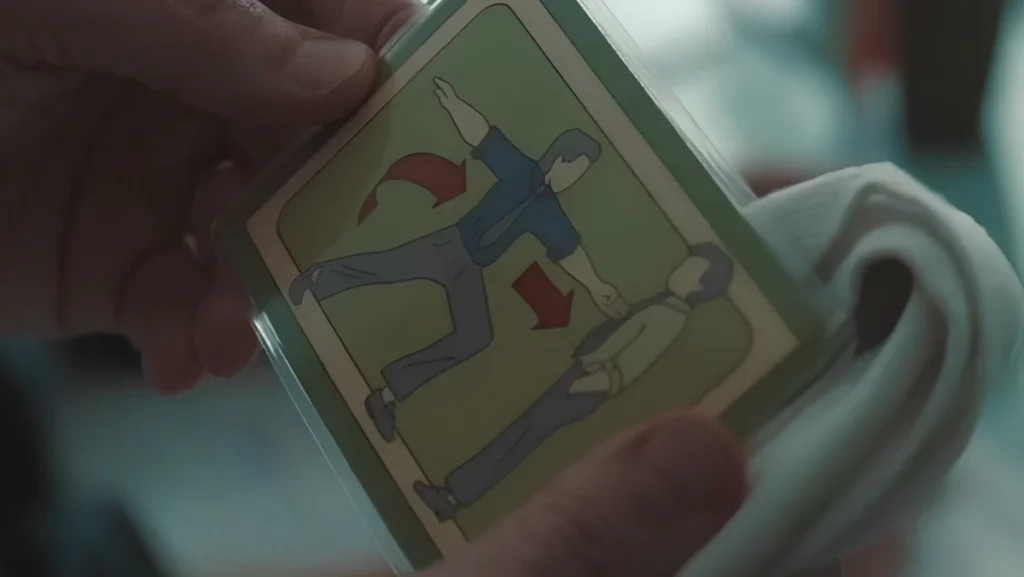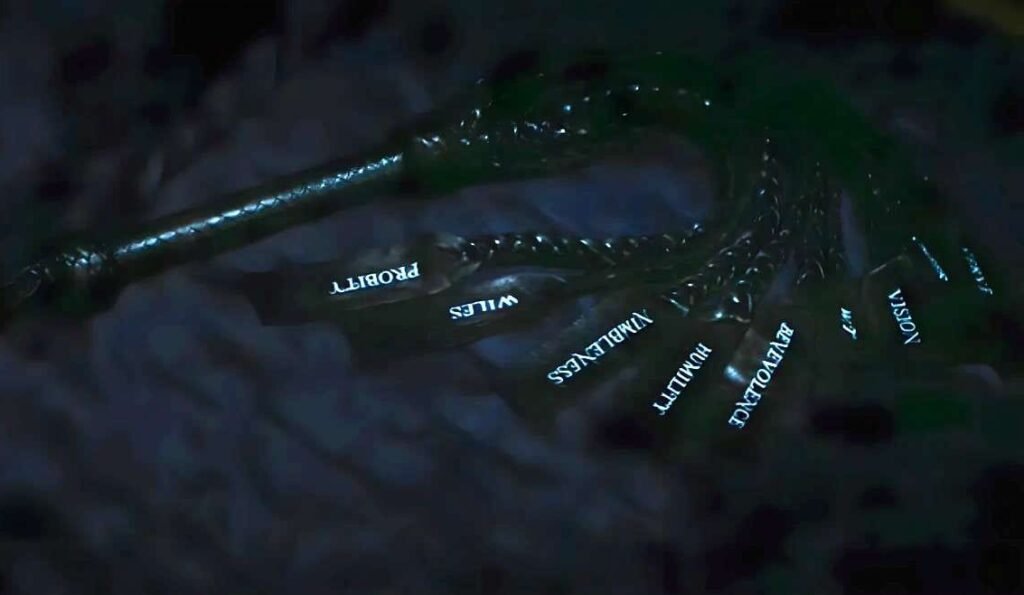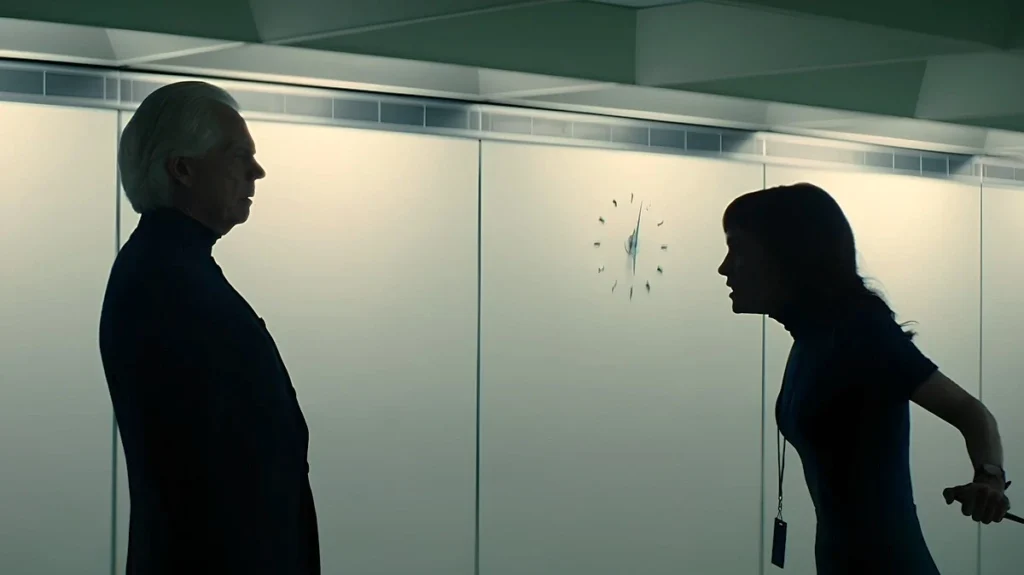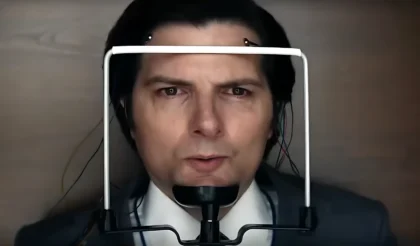Severance: More Than Just a Way to Eliminate Pain
Season two of Severance reveals that Lumon’s mental severance chip goes far beyond workplace control. The Cold Harbor Project makes it clear that the company can create multiple internal versions of a person, each with its own consciousness and memories. This development exposes the link between Lumon and Transhumanism, presenting a form of existence that is technically engineered to transcend the natural limits of the self. At first glance, this seems like a practical solution: send internal versions to deal with painful situations while the original self remains protected.
However, what if this practical goal is merely an ideological cover?
The show suggests that Lumon’s true aim is not to ease suffering, but to create a new type of consciousness: obedient, controllable, and—through the company’s eyes—more “pure.” Throughout the episodes, symbols like the Chikhai Bardo exercise, the Nine Principles of Kier Eagan, and references to the four classical temperaments suggest that Lumon operates less as a corporation and more as a transhumanist religious order in disguise.
This article gathers narrative evidence supporting that interpretation, showing how the Lumon chip may be less about separation and more about replacing humanity with a programmed psychic ideal.
1. Narrative Evidence of Lumon’s Doctrine

Severance thrives in the subtlety of its mysteries. As creator Dan Erickson points out, the answers are there—but they require deeper interpretation.
Among many clues scattered throughout the show, three recurring elements highlight Lumon’s ideological nature: the books read by Mark and Gemma, the symbolic exercises promoted in Lumon’s clinic, and the doctrinal pillars shaping the innies. What starts as an experiment to relieve emotional pain evolves into a radical redefinition of the human mind.
Read more: Mark and Gemma’s first meeting revisited
Severance 2×07: Chikhai Bardo
1.1 – Mark and Gemma: Two Paths in the Face of Pain
In episode 2×07, Mark and Gemma meet at an event before their involvement with Lumon, each reading a different book:
Gemma is exploring spiritual conversion through The Death of Ivan Ilyich by Tolstoy.
Mark, on the other hand, reads about soldiers using drugs to numb war trauma.
These choices reveal two of the show’s central archetypes:
Gemma seeks psychic transformation, transcending superficial ego.
Mark seeks to numb emotional pain.
Lumon identifies these tendencies and amplifies them strategically to shape its innies.
1.2 – Tolstoy’s Book as Gemma’s Mirror

Dr. Mauer after being hit by Gemma.
Still in episode 2×07, Gemma is seen reading The Death of Ivan Ilyich again, this time within Lumon. When Dr. Mauer notices the book, he reacts with sarcasm: “Let me guess, he dies at the end.” The moment is symbolic.
After all, Ivan Ilyich faces death only after abandoning a superficial life rooted in convention. Similarly, the show places this book in Gemma’s hands right when she is about to face the fragility of her own existence.
Thus, Gemma doesn’t attack Mauer on impulse. She’s rejecting Lumon’s imposed identity.
Like Ivan Ilyich, she confronts the fake reality Lumon wants her to accept as life—even if she can’t escape it.
1.3 – The Chikhai Bardo Exercise

Card created by Lumon (O&D) and provided at the Butzemann Fertility Center.
Gemma also undergoes a ritual in Lumon’s clinic called Chikhai Bardo, a reference to the Tibetan Book of the Dead, symbolizing ego dissolution. Gemma herself explains that the goal is to defeat the psyche, suggesting the chip doesn’t just block memories—it simulates psychological death. Lumon aims to create a “pure” consciousness, free from personal history and individual desire.
1.4 – The Nine Principles and Classical Temperaments

Representation of the nine principles on the whip used by Dylan at the Waffle Party.
From the beginning, Lumon presents the Nine Principles of Kier as religious commandments. Innies are rewarded for obedience and punished for “excessive” or non-conforming behavior. The four classical temperaments are treated as flaws to be corrected or erased.
In this light, the severance chip isn’t just practical—it’s the first step toward moral re-engineering, creating an obedient mind stripped of its history. This strengthens the link between Lumon and Transhumanism, as it proposes an evolution of humanity through selective identity elimination.
2. Does Lumon Value or Condemn Temperaments?
If Lumon seeks to eliminate human impulses, why does it embrace impulsiveness in some cases? The answer lies in the founding myth of Kier Eagan and the final episode of season two.
2.1 – Kier and Dieter in the ORTBO Walk

Interns on the RAECE (ORTBO) walk.
In episode 2×04, innies partake in a corporate ritual called ORTBO, listening to a tale about Kier and Dieter. The story implies that Dieter represents Kier’s impulsive side—one later suppressed to reinforce an idealized, controlled image.
This ambiguity suggests that Lumon doesn’t want to erase impulse entirely, but rather isolate and harness it in a productive, safe way.
Read more: The tale of Kier and Dieter explained
Kier and Dieter’s Walk – Severance Mythology
2.2 – Jame Eagan’s Words to Helly

In episode 2×10, Jame Eagan tells Helly (as an innie): “I see Kier’s flame in you.” He praises her impulsiveness and emotional intensity, as long as they are dissociated from her original consciousness. Helly becomes a safe and replicable model of channeled energy. This logic unveils yet another layer of the relationship between Lumon and Transhumanism: the company wants to preserve only the useful traits of human nature, removing all instability, unpredictability, or emotional excess.
2.3 – Ideal Consciousness: Impulse Without Ego
Lumon categorizes temperaments into Frolic, Woe, Dread, and Malice, which must be balanced according to Kier’s doctrine.
To understand the stakes of this “balance,” we can draw a parallel to the four Greek humors, reinterpreted through Lumon’s logic:
The choleric is useful, but never rebellious.
The melancholic is productive, but not paralyzed.
The sanguine entertains, but doesn’t improvise.
The phlegmatic keeps order, but never questions.
The “purity” Lumon seeks is the absence of free will. The flame Jame Eagan values is energy detached from the real individual. By reshaping humanity into an ideal mold, Lumon reveals its deep commitment to transhumanism.
To better understand how the narrative demonstrates Lumon mythology
Read more: Lumon Mythology: Symbols, Doctrine, and the Rituals of Corporate Worship
3. Lumon: A Transhumanist Religion in Disguise

Frame used in episode 2×10 demonstrating Lumon’s expectations for the completion of Cold Harbor.
Gradually, Lumon’s symbols and rituals reveal that it’s not just an extreme company. It’s a religious order aiming for ego transcendence through technology.
3.1 – Kier Eagan as Prophet

Dylan wearing Kier Eagan’s mask at the Waffle Party.
In this setting, Kier is revered as a spiritual leader. His principles act as moral commandments, celebrated in rituals that reinforce his prophet-like image.
3.2 – Rituals of Purification

Helly in the break room facing punishment.
Lumon subjects its innies to forced confessions and symbolic rewards. These rituals echo initiation rites that not only control but morally reprogram participants.
3.3 – Ego Death as Salvation
According to this doctrine, the ultimate goal becomes the destruction of ego. The aim is to create an ideal consciousness: intense, obedient, and devoid of personal history—achieved not through spirituality, but through technology.
3.4 – Dogmatic Transhumanism at Lumon
Unlike traditional transhumanism, which seeks to improve human life, Lumon redefines humanity itself, creating emotionally amputated, obedient, and predictable individuals.
4. Severance as Replacement: The Cold Harbor Project
The Cold Harbor Project isn’t just about separating consciousness for practical tasks. It also involves selecting ideal human versions that can ultimately replace the original self.
In this context, the innies serve as prototypes, tested for emotional stability and operational efficiency. Lumon may approve these versions to replace the original, erasing biography, ego, and any flawed temperaments.
Learn about the refinement processes carried out by the interns that led to the completion of Cold Harbor.
Read more: The Refinement Work in Rupture: Everything We Know
Conclusion: What Is the Connection Between Lumon and Transhumanism in Severance?

Cobel reciting the Nine Principles in episode 1×04.
Everything the show presents—from Gemma’s book to Jame Eagan’s admiration, from spiritual exercises to Kier’s mythologized stories—points in a single direction: Lumon doesn’t just want to divide the mind. It wants to shape the soul.
Its goal is not to create temporary versions of consciousness to ease trauma, but to develop and select alternative consciousnesses: more obedient, more functional, and disconnected from original identity.
That’s why the company is structured as a spiritual order and operates as a transhumanist doctrine. It doesn’t seek to enhance humanity—it seeks to replace it with a more morally useful version.
In Severance, Lumon represents a transhumanism with dogma: a belief in engineering the soul through technology. The severance chip is not a memory divider—it’s a sacred artifact, the beginning of a new religion of pure consciousness.
Posts Recomendados
Carregando recomendações...



